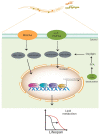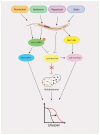Effects of High Dietary Carbohydrate and Lipid Intake on the Lifespan of C. elegans
- PMID: 34572007
- PMCID: PMC8465757
- DOI: 10.3390/cells10092359
Effects of High Dietary Carbohydrate and Lipid Intake on the Lifespan of C. elegans
Abstract
Health and lifespan are influenced by dietary nutrients, whose balance is dependent on the supply or demand of each organism. Many studies have shown that an increased carbohydrate-lipid intake plays a critical role in metabolic dysregulation, which impacts longevity. Caenorhabditis elegans has been successfully used as an in vivo model to study the effects of several factors, such as genetic, environmental, diet, and lifestyle factors, on the molecular mechanisms that have been linked to healthspan, lifespan, and the aging process. There is evidence showing the causative effects of high glucose on lifespan in different diabetic models; however, the precise biological mechanisms affected by dietary nutrients, specifically carbohydrates and lipids, as well as their links with lifespan and longevity, remain unknown. Here, we provide an overview of the deleterious effects caused by high-carbohydrate and high-lipid diets, as well as the molecular signals that affect the lifespan of C. elegans; thus, understanding the detailed molecular mechanisms of high-glucose- and lipid-induced changes in whole organisms would allow the targeting of key regulatory factors to ameliorate metabolic disorders and age-related diseases.
Keywords: C. elegans; carbohydrate; lifespan; lipids; transcription factors and metabolism.
Conflict of interest statement
The authors declare no conflict of interest.
Figures





References
-
- Minehira K., Vega N., Vidal H., Acheson K., Tappy L. Effect of carbohydrate overfeeding on whole body macronutrient metabolism and expression of lipogenic enzymes in adipose tissue of lean and overweight humans. Int. J. Obes. Relat. Metab. Disord. 2004;28:1291–1298. doi: 10.1038/sj.ijo.0802760. - DOI - PubMed
Publication types
MeSH terms
Substances
Grants and funding
LinkOut - more resources
Full Text Sources
Medical

